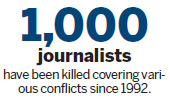Execution puts renewed focus on war coverage

A chilling video showing the execution of journalist James Foley by Islamist militants marks the second time an American reporter has been beheaded by captors overseas, echoing the murder of Wall Street Journal correspondent Daniel Pearl in Pakistan in 2002.
While Pearl worked for one of the largest news organizations in the world, Foley was on assignment for GlobalPost, an online news startup with about 28 full-time staffers that is trying to survive as a small, independent outlet.
The contrast underscores the changes that have been buffeting the news business, which in recent years has seen big staff reductions and fewer journalistic resources devoted to international coverage, including wars. At least 20 US newspapers that once maintained bureaus abroad, including The Baltimore Sun, Los Angeles Times and The Boston Globe, have closed their bureaus and scaled back foreign coverage, according to the Pew Research Center.
On the evening newscasts at the major US networks ABC, NBC and CBS, the number of minutes dedicated to overseas coverage is less than half of what it was in the late 1980s, Pew reported.
But a new crop of smaller news outlets, such as GlobalPost, Vice Media and BuzzFeed, are stepping into the breach and reporting from war zones.
There has also been an influx of freelance journalists reporting via smartphones or hand-held cameras and posting their stories online without the backing of an established media organization.
One GlobalPost contributor, multimedia journalist Tracey Shelton, launched a Kickstarter campaign to raise money to buy camera equipment, according to an online chat she conducted last year with Digital First media. Shelton did not immediately respond to a request for comment.
GlobalPost was launched in 2009 with the stated mission of helping to fill the void in international coverage. It's a for-profit news company but acknowledges that the "journey to become a self-sustaining business is far from complete", according to its website. It makes money from advertising, syndication and membership support.
Philip Balboni, co-founder and CEO of the Boston-based company, said GlobalPost requires anyone working in a conflict zone to go through hostile environment training courses. He said that GlobalPost pays for the training or contributes to the cost, depending on the circumstance.
"It really doesn't matter to us whether someone is full-time or a classic freelancer - we have always been deeply committed to our people in the field and work with people setting up careful guidelines as to how they should work," he said.
The expense of safeguarding reporters includes hostile environment and first-aid training, which costs on average $2,500 for a five-day course, said Frank Smyth, founder and executive director of security firm Global Journalist Security and an adviser to the Committee to Protect Journalists, an advocacy group.
If a reporter is captured or jailed, the cost could run into six figures annually, including paying consultants and security advisers, Smyth said. The prospect of paying a ransom also could ratchet up the cost.
Robert Mahoney, deputy director of CPJ, said even big news organizations can feel overwhelmed when one of their own goes missing in a war zone. "If you are a small news organization," he said, "it's like being hit by a tidal wave."
Since 1992, more than 1,000 journalists have been killed covering various conflicts, according to CPJ. But despite that jarring statistic and the Foley execution, news organizations, including GlobalPost, Vice and BuzzFeed, are still sending reporters into war zones and other dangerous areas.
(China Daily 08/23/2014 page12)














